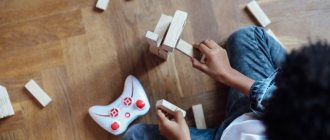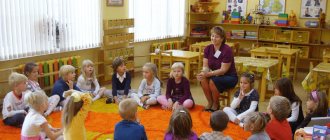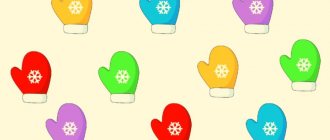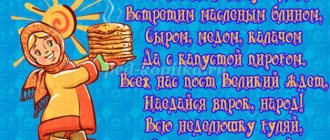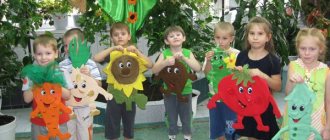Goals and objectives
Sedentary entertainment is aimed at reducing the intensity of physical activity and a gradual transition from a state of excitement to calm activity. In them, the teacher does not need to explain the rules; it is enough to independently demonstrate the movement several times or demonstrate it on any participant.
Children
In kindergarten, any form of activity is designed to diversify preschoolers. Sedentary games are no exception. Memory, attentiveness and reaction develop in a relaxed manner, and characters taken from folk tales introduce children to folk traditions.
Note! In winter they are held indoors without fail. They practice on the site near the veranda or inside it in the spring, summer and autumn days.
Sedentary games in the senior group are aimed at:
- Introducing the habit of changing active activities to low-intensity activities.
- Increased verbal-logical memory (reproduction of rules dictated aloud).
Low mobility games in the preparatory group - a card index with goals.
Card index of sedentary games
| Name | Target | Description | Note |
| Bubble | Development of discipline, attention, ability to act on command | Children stand in a circle and hold hands. The teacher reads the poem; while the reading is happening, the children move away, enlarging the circle. As soon as the words “The bubble burst” are pronounced, the kids should lower their hands and pronounce the sound “ssss”, imitating a deflated balloon. | Poem: “Blow up a bubble, Blow up big, Stay like that and don’t burst.” The game takes place 2-4 times. |
| Kitty | Develops dexterity and artistic qualities | The task is given - to portray a cat, crawling on all fours. When called, stop and look around, turn your head or tilt it (drink milk). You can also add tasks in which the cat crawls between your legs, climbs to heights, and purrs. | |
| Attractions | Thinking and memory are developing | Place children at the table, fingers should be on the surface. The teacher names any objects, animals, birds, etc. When a flying object is named, the kids must raise all their fingers up. | |
| Ocean is shaking | Attention and discipline develop, children learn to follow the rules of the game | Chairs are placed, the number of which is 1 less than the number of players. At the verbal command “the sea is rough,” children run around the chairs. As soon as you hear “the sea has calmed down,” you need to take a chair. There isn't enough chair for one - he goes to drive. | It is best to play this game while walking in the summer. Children should be prevented from running too close to chairs. Also strictly monitor compliance with the rule - take a chair only when the words “the sea has calmed” are heard. |
Development of emotional intelligence in preschoolers
Sedentary games. Card index for the second junior and middle group
Card index of sedentary games
(for the second junior and middle group)
“Who will walk quietly” Objectives: to familiarize with walking in a given direction, to develop the ability to maintain balance. Progress of the game: Children walk in a free formation in one direction. The teacher offers to walk quietly on tiptoes (shows how to do this). Then he gives a signal: “Now let’s walk quickly.” The walking speed changes several times according to the signal. “Balloon” Game progress: Children depict how a balloon is gradually filled with air: they slowly raise their hands up and puff out their cheeks. But the balloon “burst”: the children slowly, in a relaxed state, sink to the floor, saying: sh-sh-sh “Grains.” Tasks: teach children to act according to the rules, develop perseverance. Progress of the game: Educator: Planted the seeds in the ground. (Children sit on the floor, squeeze into a ball.) It rained, and then the sun shone. The grains began to sprout, sprouts appeared. (Children slowly rise, pull themselves up, raising their hands - the “sprouts” - up and turning towards the “sun”). “Bubble” Objectives: to teach children to act on the teacher’s command, to develop attention. How to play: Children and an adult stand in a circle holding hands. Educator: Blow up a bubble.
Pout big. Stay like this and don't burst out.
Children gradually move back to expand the circle. When they hear the words “The bubble burst,” they lower their hands and say “sh-sh-sh.” The game is repeated 2-4 times. "Kwa-kwa-kwa"
Objectives: develops auditory memory and, to some extent, coordination of movements and attentiveness.
Description of the game: The leader is blindfolded, and the rest of the children stand around him.
The presenter begins to spin and pronounce a chant:
"Here is a frog along the path
Jumps, stretches out her legs,
I saw a mosquito and screamed...
“At the word “shout,” the leader points his fingers in front of him.
The player to whom the presenter points (or closer to whom) says: “Kwa-kwa-kwa.” The presenter must say the name of this player.
If the leader guessed correctly, then the identified player becomes the next leader, otherwise the leader repeats everything.
Rules of the game
The leader is blindfolded, and the rest of the children stand around him. The leader spins around and says the above chant. At the word “screamed,” the leader points his fingers in front of him, and the player to whom he is pointing must say: “kva-kva-kva.” If the leader is correct guesses who is in front of him, then this player becomes the leader, otherwise the game starts again from the second point.
Notes: The GM is not allowed to touch the players.
To complicate the game, it is allowed to pronounce qua-qua in an unnatural way.
yourself with your voice
“Kitty” Objectives: the game develops artistry and dexterity. Progress of the game: The child crawls on all fours, pretending to be a cat. He stops and turns his head (the cat looks around), then tilts his head (the cat drinks milk). For children over two years old, you can complicate the game: the cat crawls between the legs of an adult, under a chair, climbs onto the sofa, lies down, purrs.
“Humpty Dumpty” Game progress Children stand in a relaxed position, arms hanging freely. Under the text that the adult pronounces, turn the body left and right (the arms should dangle freely, like a rag doll). Educator: Humpty Dumpty
was sitting on the wall. Humpty Dumpty . Fell in his sleep.
The children relax on the floor. The game can be played with one child or with a subgroup of children.
“Cold-warm” Objectives: develops attention and thinking. How to play: Children sit on the carpet with their legs folded cross-legged. Educator: The north wind blew. It became cold and cold. (Children hunch into balls, crossing their arms over their chests.) At the signal, “The sun has come out. It has become warm and warm.” The children relax and fan themselves. The game is repeated 2-3 times. "Find a Pair"
Find a pair - the game develops classification and sorting skills, hand-eye coordination, hand motor skills, and thinking skills. Description of the game: Objects that match each other according to some characteristics are laid out on the table. Mix them. The child is asked to take any object and find a pair for it, and then explain why he considers these objects to be paired. Rules of the game: Various objects are collected that are combined with each other (pencil and paper, sock and shoe, lock and key, etc.)
Place the items on the table and mix them.
The child is seated at the table.
The adult chooses any object and asks the child to find a pair for it (or the child chooses the object independently).
If the child finds a pair, it is put aside.
Take the next item and repeat the same thing.
The game continues until all the items are collected in pairs.
Note: Instead of objects, you can use pictures from the object.
“Find by Description” Find by Description is a game for children two to three years old. Promotes the development of observation, memory and attention of the child. Game description: Ask the child to show what you describe to him. For example: “Please show me the object. It is round, one side is red and the other is blue. You can play with it: roll it, throw it to each other” (this is a ball). Rules of the game: Describe an object to the child: its color, shape, what it is made of, what can be done with it. The child guesses from the description and names the object
Note: You can describe people, animals, nature - precipitation, trees... (and everything that surrounds us) and ask the child to guess who/what you are talking about.
"Silence"
Objectives: the game develops speech and memory with the help of rhymes. Before the start of the game, the players say in chorus: Firstborns, firstborns
The bells rang. Along fresh dew, Along someone else's lane. There are cups, nuts, honey, sugar. Silence!
After the word “Silence” everyone must be silent. The presenter tries to make the players laugh with movements, funny words, and nursery rhymes. If someone laughs or says one word, he gives the presenter a forfeit. At the end of the game, children redeem their forfeits: at the request of the players, they sing songs, read poetry, dance, and perform interesting movements. “Girls and Boys” Objectives: to develop freedom and imagination in children. Game description: Girls and boys sit opposite each other. The boys start the game. They take turns calling any girls' names. If there is a girl whose name was spoken, she stands up and says her name again and talks a little about herself. After this, it’s the girls’ turn and they start calling out the boys’ names. Rules of the game: Girls and boys sit opposite each other. The boys start the game. They take turns calling any girls' names. If there is a girl whose name was pronounced, she stands up and says her name again and talks a little about herself. After this, it is the girls' turn and they begin to call the boys' names.
“Amusement Park” Objectives: to teach children to act according to plan; develop attention. Children stand in pairs around the hall and perform movements in accordance with the text. Text: Movements: We sat on the carousel, holding hands, spinning.
The carousel started spinning.
We moved to the swing. Holding hands: one player stands,
They flew up and down.
the other crouches.
Holding hands, And now you and I
are swinging together: left and right, forward -
We are sailing on a boat.
back.
We will go ashore from the boat.
And let's jump across the lawn, Like bunnies, like bunnies. Jumping on two legs.
“Amusement Park” Objectives: develop memory and thinking. This game takes place at the table. The players place their fingers on the table, the leader names birds, animals, insects, flowers, etc. When naming a flying object, everyone should raise their fingers up. Whoever raises his fingers when naming a non-flying object, or does not raise his fingers when naming a flying object, pays a forfeit.
“The sea is agitated” Objectives: to develop attention, teach to act according to the rules. According to the number, the player places chairs in two rows so that the back of one chair touches the back of the other. All participants in the game sit on chairs. says: “The sea is worried.” The players get up and run around the chairs. “The sea has calmed down,” says the driver, and the children take the empty seats. Someone will be left without a seat because one chair is occupied by the driver. The one who missed out goes to drive. Rules
1. Players are not allowed to run close to the chairs. 2. You can take an empty seat only after the words “The sea has calmed down.”
“Herringbone” (game for children 4-6 years old)
Children stand in a circle or scattered.
The f/k instructor shows the movements and pronounces the text, the children repeat the movements. Our Christmas tree is beautiful, (They walk in a circle, holding hands.)
Has risen to the heavens,
(Stop, stretch their arms up.)
Slender beauty,
(Again they walk in a circle, holding hands.)
All the kids like it.
(Stop.)
“Along the path” (game for children 4-6 years old)
Children stand in a circle or scattered.
The f/k instructor shows the movements and pronounces the text, the children repeat the movements. One, two, three, four, five, Let's stretch our legs. We walk along the road, Raising our feet higher. (Walking in place.)
And along the same path We gallop on the right leg.
(Jump on your right leg.)
And now let’s jump a little more on the other leg.
(Jump on your left foot.)
Let's run along the path and reach the lawn.
(Running in place.)
On the lawn, on the lawn We will jump like bunnies.
(Jumping in place on two legs.)
We will clap our hands, Let our legs dance.
(Free dance moves)
Stop.
Let's sit down and rest. (Squats.)
And we’ll walk back.
(Walking in place.)
“Don’t wake the bear!” (game for children 4-6 years old)
Children stand up and join hands.
The teacher stands with the children in a circle. Everyone dances in a circle, reciting a poem and performing the movements: Like snow, snow on a hill, And snow, snow under a hill. (They turn in the opposite direction and dance in a circle.) And there is snow, snow under the tree, and snow, snow on the tree. (They all go together to the center of the circle.)
And a bear sleeps under the tree.
"Hush hush! Don’t wake me up, sit down, don’t make any noise!” (Squat down.)
“Earth, water, air”
(game for children 5-7 years old)
Children sit in a circle or in a row. The presenter walks between them and, pointing at each in turn, says the word: “Water! " The child he pointed to must name a fish or animal that lives in the water. If the driver says the word “earth,” the child names the one who lives on the earth, if the word “air” is named, the one who flies.
“Mail” (game for children 5-7 years old)
The game begins with a roll call between the driver and the players: “Ding, ding, ding!”
-Who's there? - Mail. - Where? - From the land of fairy tales. - What are they doing there? - They wash themselves (dance, draw, run, comb their hair, squat, smile, etc.)
.
The players imitate or perform the named action. “Guess what they did” (game for children 5-7 years old)
Children stand in a circle or scattered. The teacher selects one child who moves 8-10 steps away from everyone playing and turns his back to them. He must guess what the players are doing. Children agree on what action they will portray. According to the teacher: “It’s time! "The driver turns, approaches the players and says: Hello, children! Where have you been? What did you know? The children answer: We won’t tell you what we saw, but we’ll show you what we did. If the driver guesses correctly, he chooses another child instead. If he answers incorrectly, the game is repeated with the same driver.
"Clean" (game for children 5-7 years old)
Children stand in a circle or scattered.
The teacher shows the movements and pronounces the text, the children repeat the movements and text. If you like it, then do it. (Two claps of hands.)
If you like it, then do it that way.
(Two claps of your hands.)
If you like it, then show it to someone else. If you like it, then do it this way.
(Two claps of hands.)
Then the words are repeated, but with different movements: children clap their knees, press their hands to their cheeks, say: “Ay-ay,” touch their nose with a finger and say: “Beep.” You can come up with other funny movements. In conclusion, after each line, the children sequentially repeat all the movements shown earlier. It is important not to make a mistake in the sequence and perform the movements at a fast pace.
“Monkeys” (game for children 4-7 years old)
Children stand in a circle or scattered.
The teacher shows the movements and pronounces the text, the children repeat the movements in accordance with the text. We are funny monkeys. We play too loud. We clap our hands, (Clap.)
We stomp our feet,
(Stomp.)
Puff out our cheeks,
(Puff up our cheeks.)
We jump on our toes
(Bounce in place.)
And we’ll even show each other our tongues.
(They show their tongue.)
Let's jump together to the ceiling,
(They jump up.)
We'll raise our finger to our temple.
(They bring a finger to their temple.)
We’ll open our mouth wider,
(They open their mouth.)
We’ll make all the grimaces.
(They make faces.)
As soon as I say the number 3 - Everyone, freeze with grimaces!
“Ball” (game for children 5-7 years old)
Children stand in a circle or scattered.
The teacher shows the movements and pronounces the text, the children repeat the movements. Ten, nine, (Clap their hands.)
Eight, seven,
(Slap their knees.)
Six, five,
(Clap.)
Four, three,
(Slap.)
Two, one.
(They clap.)
We are with the ball
(They cover their eyes with either the inside or the outside of their palm.)
We want to play.
We just need to find out: (They clap for every word.)
Who will have the ball
(They stomp for every word.)
Catch up.
(Squat.)
“Horns and legs”
(game for children 6-7 years old)
The middle and ring fingers are bent, held on top by the thumb, the index and little fingers are extended; the hand is raised up - these are horns. The index and middle fingers are extended, the ring and little fingers are pressed to the palm and held with the thumb; the hand is lowered down - these are the legs. One hand shows the horns, the other shows the legs. Then the hands simultaneously change roles.
How to fill out a summary of low mobility games for children 5-6 years old in the senior group
Teacher's notes
The teacher’s reference table is filled out according to the following points:
- Author of the program (name of teacher, kindergarten number, city and region).
- Name of the exercise.
- Goals and objectives.
- Necessary materials.
- Progress of the game.
- Summarizing.
The value of sedentary games is to create positive emotions in children and relieve stress and muscle tension after active activities. Low-intensity exercises are an excellent option for your child to keep busy independently in the company of their peers.
Stages of implementation in senior and preparatory groups
Conducting games in the older group with low mobility is divided into several periods:
- Gather the kids to start. The call is a whistle. If desired, a surprise is added - the teacher shows a small letter or a video recorded by a fairy-tale character, setting up the theme of a sedentary game selected from the card index with the goals in the senior or preparatory group.
- Start. If there was a surprise, then you should get acquainted with its contents (read the letter, watch a video from a fairy-tale character). Next, have a conversation and show with a video or photo an example of what needs to be done in the proposed game. At the same time, the teacher with expression reads a poem on the relevant topic. If the exercise is familiar to kids, invite them to guess the name from the pictures.
- The explanation in the senior and preparatory groups occurs verbally, without showing movements. Exercises familiar to children are explained in the format of questions on knowledge of the rules.
- Game process. During the first meeting, the role of the facilitator lies with the teacher. When repeating, children choose the main thing on their own, and the teacher only guides them along the way.
- At the end, it’s worth summing up and asking questions: “How interesting was the game?”; “What did you feel during the process?”
